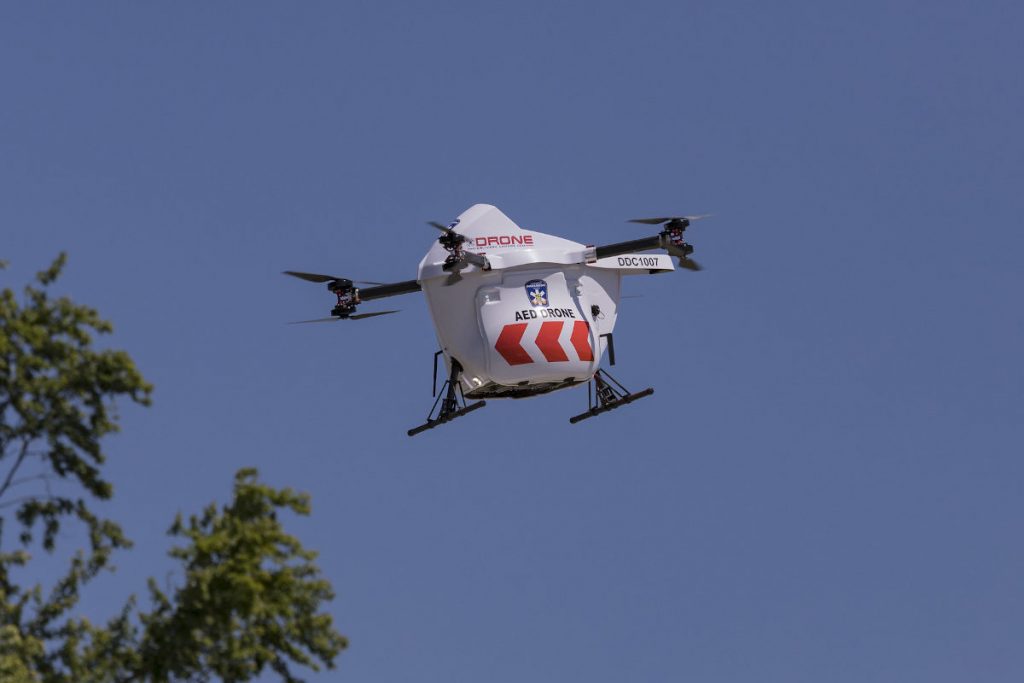
News
Drones
Drone Delivery Canada completes Phase Three of AED On the Fly project
November 12, 2020 By Helicopters Staff
 Drone Delivery Canada's AED Sparrow drone. (Photo: CNW Group, Drone Delivery Canada)
Drone Delivery Canada's AED Sparrow drone. (Photo: CNW Group, Drone Delivery Canada) Drone Delivery Canada Corp. on November 6 completed Phase Three of its AED (Automated External Defibrillator) On the Fly project with Peel Region Paramedic Services and Sunnybrook Centre for Prehospital Medicine.
The company marked off the completion of the project’s Phase One and Phase Two, testing, back on 26, 2019, and July 6, 2020. As with the first two testing period, Phase Three also utilized the Sparrow drone with its cargo drop capability and audio announcement system, to drop an AED where a designated untrained (lay) bystander would then retrieve the AED and apply it to a simulated cardiac arrest patient in a rural environment.
“This partnership between DDC, Peel Regional Paramedic Services and Sunnybrook Centre for Prehospital Medicine is ground-breaking,” said Michael Zahra, president and CEO of Drone Delivery Canada.
Response time to drop, retrieve and apply an AED, and physiological and psychological human factors in a stressful situation were measured during the testing.
Additionally, remote launch and monitoring from the company’s Vaughan, Ontario Operations Control Centre (“OCC”), and nighttime delivery of an AED by drone were successfully tested. The testing validated that using Drone Delivery Canada’s (DDC) proprietary drone delivery platform with cargo drop functionality to deliver rapid first responder technology via drone may reduce response time to cardiac arrest patients in the field while being utilized by lay responders.
Simulated 911 call locations were electronically sent to the company’s OCC for drone launch. The Sparrow drone flew automatically from a Peel Paramedic station in Caledon, Ontario, to the destination and back. Real-time remote monitoring occurred from the OCC using DDC’s proprietary FLYTE software system. Round-trip flight distance was approximately 12 km. Compared to a land-based vehicle, the AED drone had a shorter travel time, explains DDC, a major factor in responding to a cardiac arrest.
“Phase Three allowed us to continue our progress towards implementing drone technology to improve outcomes from rural and remote cardiac arrest,” said Dr. Sheldon Cheskes, associate professor at the Department of Family and Community Medicine, University of Toronto, and the principal investigator of the AED On the Fly Pilot research program. “Working with lay responders, we continued our simulated cardiac arrest scenarios and optimized the ease of use of an AED delivered by drone through real-time feedback to lay responders as well as performing night flights to ensure 24/7 capability of this unique AED solution.
“Finally, and most importantly, the launch and monitoring of the drone occurred from the Operations Control Centre at DDC headquarters in Vaughan, Ontario, reconfirming the capabilities of DDC’s remote monitoring with FLYTE,” added Cheskes. “All these factors strengthen the likelihood that not only may drones decrease time to first AED shock in rural and remote communities but the fear of AED use can be minimized by real-time interaction between a first responder and trained personnel.”